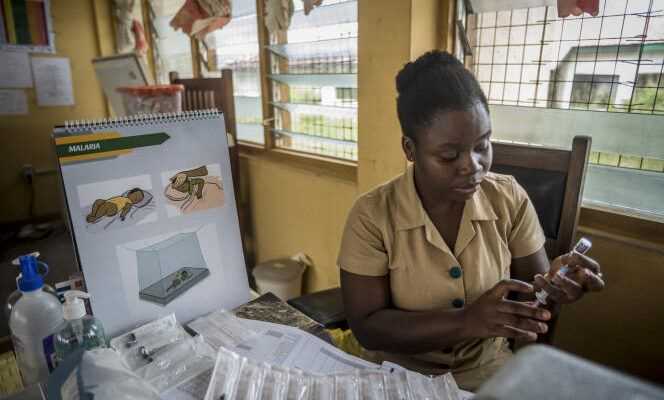To not miss anything on African news, subscribe to the newsletter of World Africa from this link. Every Saturday at 6 am, find a week of current events and debates treated by the editorial staff of “Monde Afrique”.
In Ghana, malaria remains a major scourge. In this West African country, malaria is endemic throughout the country, all year round. With Kenya and Namibia, Accra has been experimenting since 2019 with a pilot vaccination program with RTS, S (Mosquirix), developed by the British laboratory GlaxoSmithKline.
Some 230,000 Ghanaian children have benefited, 800,000 in all in the three pilot countries. Despite limited results (it can reduce malaria episodes by around 30% and severe episodes by 40%), the World Health Organization (WHO) recommended its expanded deployment in October, hoping that the vaccine would allow gains in the fight against the parasite.
In Ghana, as in most countries of sub-Saharan Africa, malaria is the leading cause of pediatric hospitalization and the leading cause of infant mortality. While the country recorded a sharp drop in the incidence and mortality due to the disease between 2005 and 2015 (- 50% and – 65% respectively), they have increased slightly since 2019.
In the field, vaccine experimentation remains little known. In the north of the country, hardly anyone has heard of the Mosquirix. This rural region, among the poorest in Ghana, is also one of the most affected by malaria with a prevalence of 32% (against 4% in the Accra region, the richest in the country), particularly strong during the rainy season, from May to the end of October.
“Protect yourself with mosquito nets”
Near the large northern city, Tamale, in Savelugu, nurse Najat Abdullai brings together, as she does once a month, a support group of mothers. The objective of this meeting between women, organized under the aegis of the development NGO Vision du monde, is to freely address all the health issues that concern them.
In these groups, malaria returns as one of the main topics of discussion, along with the feeding and education of children. How to protect newborns? How to spot the signs of a malaria infection and how to act?… Najat Abdullai puts all his energy to answer the questions of these women and to encourage the sharing of information.
Afi Wumbie explains that her third child, an 18-month-old girl, contracted malaria during the summer. Fever, yellow complexion … The mother very quickly suspected malaria and was able to consult quickly at the health center in the neighboring village. “I was very scared for her because she had a very high fever, says Afi Wumbie, but, as it was quickly taken care of, I did not tell myself that I would lose it. After three days of treatment, she was already getting better. “
Unfortunately, not all children in Ghana recover from an episode of malaria. Each year, 20,000 of them die from it, a quarter of which are less than 5 years old. “We do a lot of teaching on the importance of protecting yourself, especially with mosquito nets”, insists Najat Abdullai. In Savelugu, the state recently distributed bed nets. The twenty women gathered that day ensure that their young children sleep under mosquito nets impregnated with insecticide.
Disease of poverty
Access to this equipment, which is crucial for preventing bites, remains unequal in the country. In 2019, 73.7% of Ghanaian households had access to at least one treated mosquito net, according to the WHO. Just over half of children under 5 were able to sleep under this equipment. Despite the pandemic, the country has continued its distributions as best it can, but, by the end of October, the authorities had only sent communities 76% of the 16 million mosquito nets planned for its 2021 campaign.
As observed globally, national statistics confirm that malaria is first and foremost a disease of poverty. In the poorest Ghanaian households, it affects 32% of children under 5, while only 3% of children from the wealthiest families are affected (the average prevalence being 21% nationwide. ).
When asked if mothers in Savelugu would vaccinate their child against malaria if they had the possibility, most responded with a ” Yes ” franc. A determination that contrasts with their questions about the vaccine against Covid-19, which is the subject of many rumors in the region. It is because the threat of malaria is perceived as immediate, everyone knowing a person affected around them, when the Covid-19 is for its part a distant shadow.
The Ghanaian authorities hope that the vaccination will generate adherence and reduce the number of hospitalizations by 100,000 per year, but its large-scale expansion represents a logistical challenge: the Mosquirix indeed requires four injections, at one, six and nine months. , then a recall after two years.
